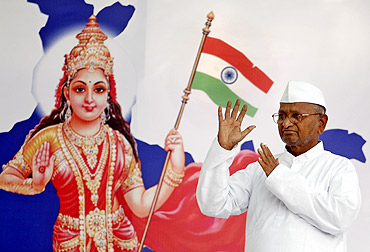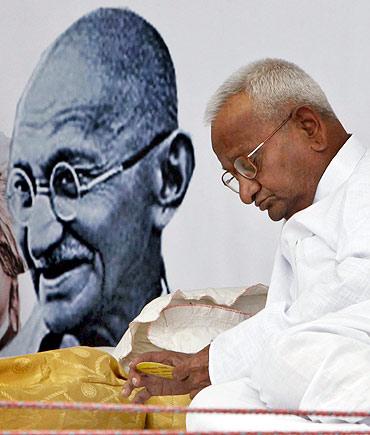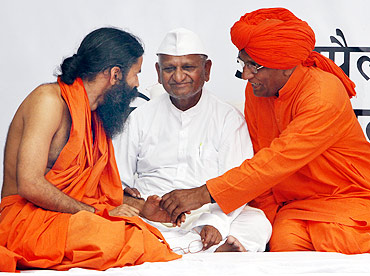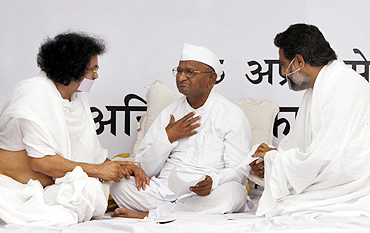This article was first published 14 years ago
Home »
News » Anna Hazare and his 80s revolution
Anna Hazare and his 80s revolution
Last updated on: April 9, 2011 09:11 IST
Image: Social activist Anna Hazare waves to his supporters during his fast-unto-death campaign in New Delhi
Photographs: Parivartan Sharma/Reuters
Sunita Narain profiles the man who never took half steps to development and transformed a drought-hit village into a prosperous one back in the 1980s.
The first time I met Anna Hazare was in the mid-1980s. My colleague Anil Agarwal was travelling in search of answers to how India could regenerate lands and address desperate poverty.
We heard about a village, Ralegaon Siddhi, in the drought region of Ahmednagar. It was peak summer. We were led to a small temple where we were introduced to a diminutive man, who, we were told, was spearheading change in the village.
This was Kishan Baburao Hazare (Anna), a driver in the Indian Army, back to 'fix' his village.
...
Image: Anna Hazare is a Gandhian
Photographs: B Mathur/Reuters
I have a vivid memory of that hot day when I was given my first lesson on watershed development. The village was surrounded by small hills, completely barren and desolate. What I could see were pits being dug across the contours.
Anna Hazare explained that this was the start of the ridge-to-valley model -- rain would be trapped in the trenches, slowing the flow of water to recharge groundwater. Then, trees would be planted and grazing stopped; and the hills would be the catchment for the village's water endowment.
He then took us to see a series of check-dams on the streams, ponds in fields and percolation dams in the valley. The principle was the same: Hold the rain where it falls and use water to build the economic base of the village.
Image: Hazare rests during his recent campaign
Photographs: Parivartan Sharma/Reuters
This worked. We went back in the 1990s to study the change. The results were astounding. The hills were green, grass-laden, the wells in this drought-stricken area were full of water and fields were rich with crops. The economic analysis we did then showed that this was no mean change. By then the village had invested Rs 75 lakh through government schemes and voluntary labour.
And the returns were high. Incomes had risen, so that over a quarter of the village earned more than Rs 5 lakh annually (this was a time when the super-rich in India were defined as those who earned more than Rs 10 lakh annually). Most importantly, income disparities were low.
Image: Yoga guru Swami Ramdev speaks with social activist Swami Agnivesh as Anna Hazare
Photographs: B Mathur/Reuters
The transformation was a lot to do with Anna's personality. When he had gone back to the village, it was a 'den of drunkards' (in his words).
The first thing he did was to ban alcohol. He stopped television viewing and insisted that all residents contribute to community labour.
He started a school, where the only qualification for admission was that the student had to be a dropout. Every student excelled. He was not willing to take half steps to development.
Image: Hazare with men from the Jain community
Photographs: B Mathur/Reuters
It is this steely determination that has brought many to their knees. Based on Ralegan, the state government launched the Adarsh Gram Yojana (model village plan). It worked on five principles -- ban on cutting trees, free from grazing and liquor; strict family planning and contribution of voluntary labour for development works.
I would not say that the scheme, with its many prohibitions, was a hit in the modern and free society of rural Maharashtra. But I would definitely argue that Anna Hazare's Ralegaon Siddhi remains a pilgrimage for all to understand the potential of a new model, where ecological and natural wealth can create well-being and economic growth. The village has become the basis of planning across the country. This is no small change.
Source:





